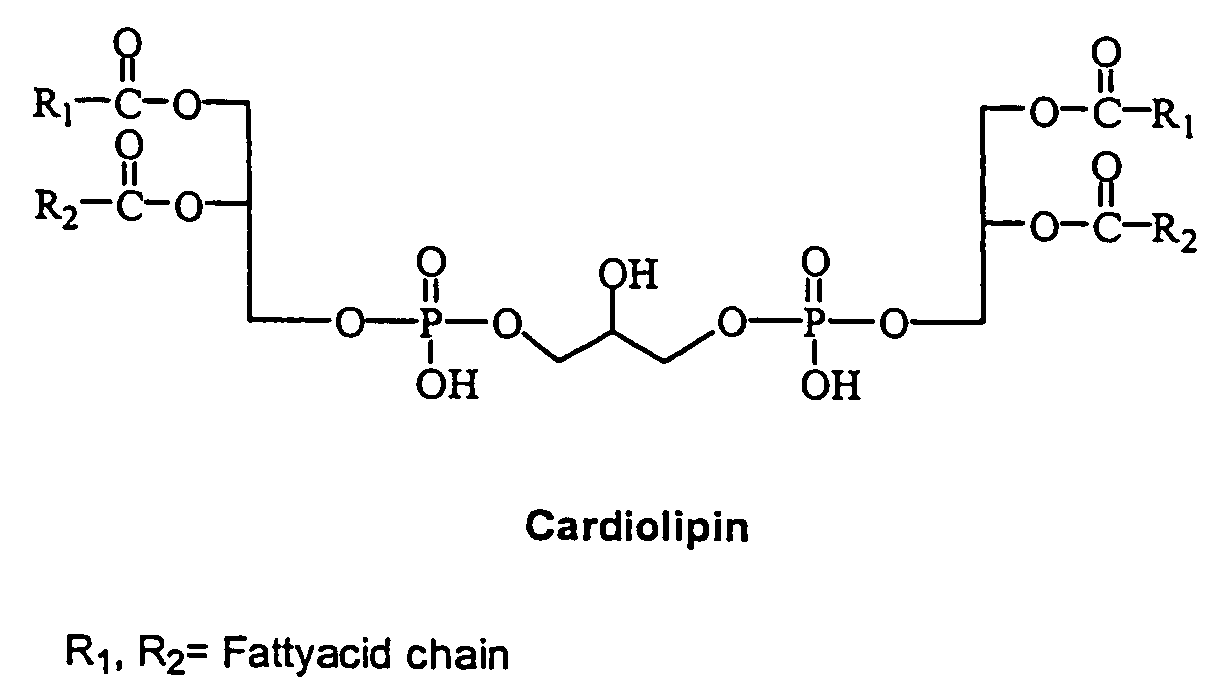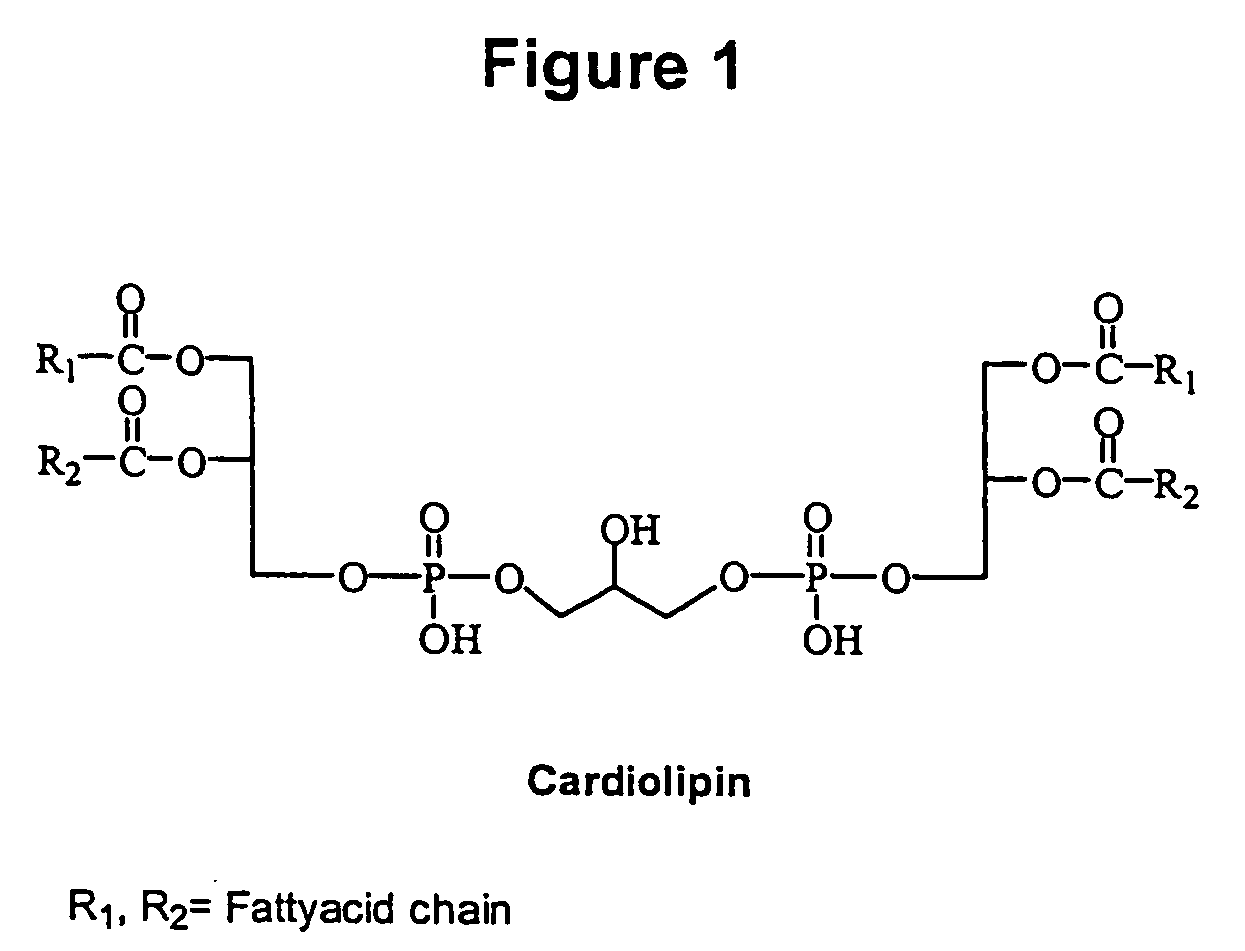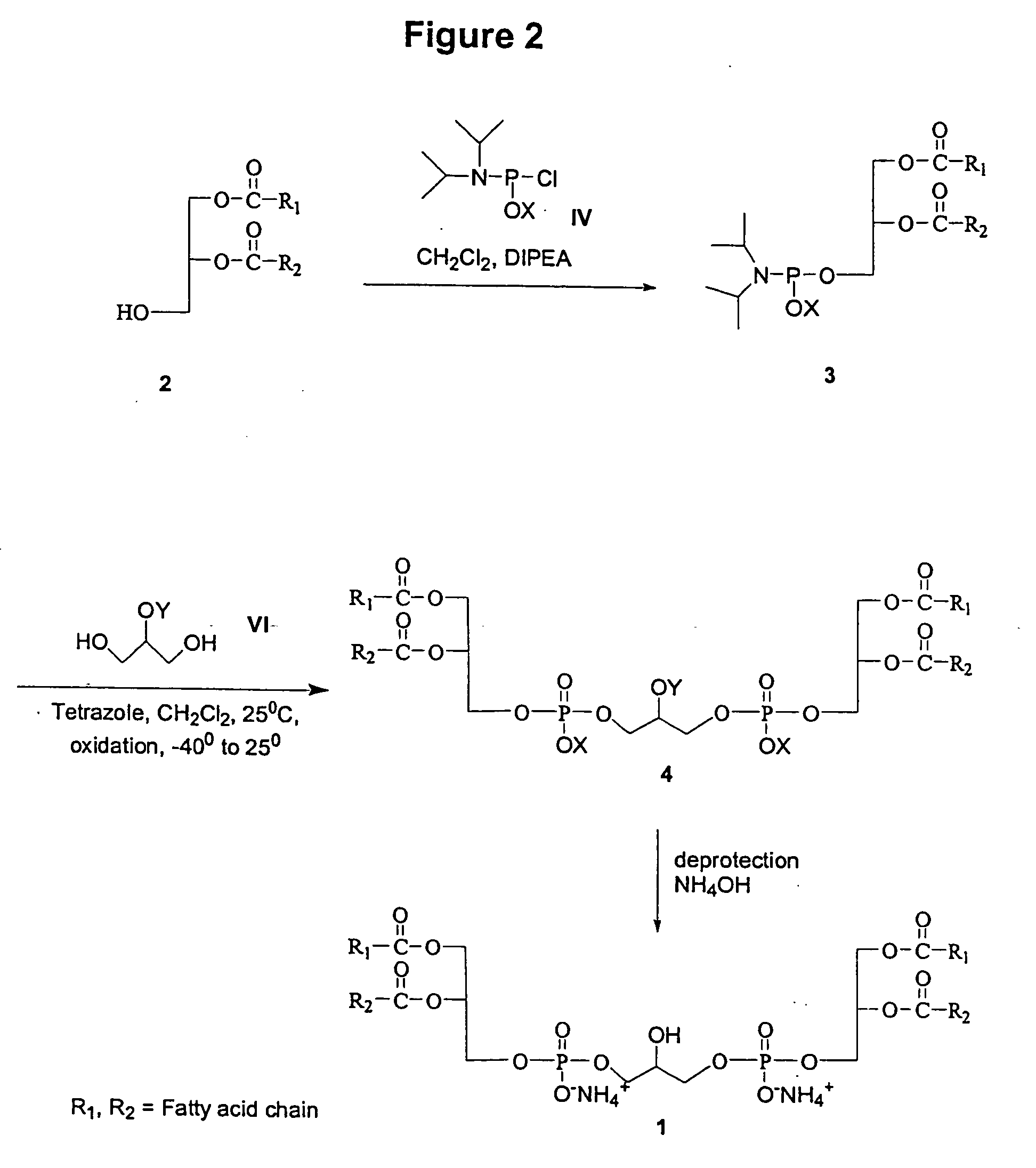Cardiolipin molecules and methods of synthesis
- Summary
- Abstract
- Description
- Claims
- Application Information
AI Technical Summary
Benefits of technology
Problems solved by technology
Method used
Image
Examples
example 1
Synthesis of Tetramyristoyl Cardiolipin
1A. 2-Benzyl-1,3-bis [(1,2-dimyristoyl-sn-glycero-3)-phosphoryl]glycerol dibenzyl ester
[0063]
[0064] A solution of 1,2-dimyristoyl-sn-glycerol (10 g, 19.53 mmol), benzyl N,N-tetraisopropyl phosphoramidite (9.87 g, 29.29 mmol) and 1H-tetrazole (65 mL of 0.45 M sol in acetonitrile, 29.29 mmol) in CH2Cl2 (125 mL) was stirred at room temperature under argon for 3 h. A solution of 2-benzyloxy 1,3-propanediol (1.18 g, 6.47 mmol) in CH2Cl2 (20 mL) was added followed by 1H-tetrazole (37.7 mL of 0.45 M sol in acetonitrile, 16.85 mmol) and stirred for 3 h. The reaction mixture was cooled to −40° C. and tert-Butyl hydroperoxide (TBHP, 6.4 mL of 5-6 M sol in decane, 32.35 mmol) was added. After stirring at −40° C. for 30 minutes, the reaction mixture was warmed to room temperature, diluted with CH2Cl2 (250 mL), washed {saturated aq Na2SO3 (2×50 mL), saturated aq NaHCO3 (2×50 mL), brine (2×50 mL)} dried (Na2SO4) and concentrated. The residue was purified o...
example 2
Synthesis of Tetralauroyl Cardiolipin
2A. 2-Benzyl-1,3-bis [(1,2-dilauroyl-sn-glycero-3)-phosphoryl]glycerol dibenzyl ester
[0067]
[0068] Method 1: A solution of 1,2-dilauroyl-sn-glycerol (2.2 g, 4.82 mmol), benzyl N, N-tetraisopropyl phosphoramidite (1.95 g, 5.78 mmol) and 1H-tetrazole (12.84 mL of 0.45 M sol in acetonitrile, 5.78 mmol) in CH2Cl2 (25 mL) was stirred at room temperature under argon for 3 h. A solution of 2-benzyloxy 1,3-propanediol (352 mg, 1.92 mmol) in CH2Cl2 (10 mL) was added followed by 1H-tetrazole (12.84 mL of 0.45 M sol in acetonitrile, 5.78 mmol) and stirred for 3 h. The reaction mixture was cooled to −40° C. and 3-Chloroperoxyperbenzoic acid (m-CPBA, 2.77 g, 9.64 mmol) was added in portions. After stirring at −40° C. for 30 minutes, the reaction mixture was warmed to room temperature, diluted with CH2Cl2 (150 mL), washed {saturated aq Na2SO3 (2×50 mL), saturated aq NaHCO3 (2×50 mL), brine (2×50 mL)} dried (Na2SO4) and concentrated. The residue was purified o...
example 3
Synthesis of Tetralauroyl Cardiolipin
[0072] In this method the tetralauroyl cardiolipin was synthesized by 2-cyanoethyl phosphoramidite.
3A. 2-Benzyl-1,3-bis [(1,2-dilauroyl-sn-glycero-3)-phosphoryl]glycerol dicyanoethyl ester
[0073]
[0074] To a mixture of 1,2-dilauroyl-sn-glycerol (1.74 g, 3.79 mmol) and N,N-diisopropylethylamine (545 mg, 4.22 mmol) in anhydrous ether (20 mL) under argon atmosphere was added 2-cyanoethyl diisopropylchlorophosphoramidite (1 g, 4.22 mmol). The mixture was stirred at room temperature for 1 h, the separated disiopropylamine hydrochloride was filtered, and the filtrate was concentrated in vacuo. The residue was as such used for the phosphorylation.
[0075] To a mixture of above phosphoramidite and 1H-tetrazole (9.4 mL of 0.45 M sol in acetonotrile, 4.22 mmol) in anhydrous CH2Cl2 (30 mL) was added a solution of 2-benzyloxy 1,3-propanediol (312 mg, 1.71 mmol) in CH2Cl2 (5 mL). The reaction mixture was stirred at room temperature for 3 h and cooled to −40° ...
PUM
| Property | Measurement | Unit |
|---|---|---|
| Composition | aaaaa | aaaaa |
| Pharmaceutically acceptable | aaaaa | aaaaa |
Abstract
Description
Claims
Application Information
 Login to View More
Login to View More - R&D
- Intellectual Property
- Life Sciences
- Materials
- Tech Scout
- Unparalleled Data Quality
- Higher Quality Content
- 60% Fewer Hallucinations
Browse by: Latest US Patents, China's latest patents, Technical Efficacy Thesaurus, Application Domain, Technology Topic, Popular Technical Reports.
© 2025 PatSnap. All rights reserved.Legal|Privacy policy|Modern Slavery Act Transparency Statement|Sitemap|About US| Contact US: help@patsnap.com



